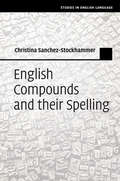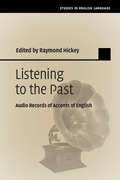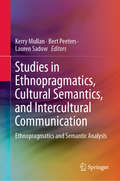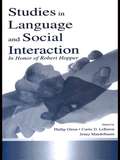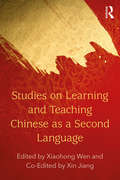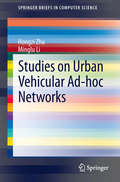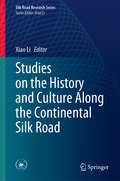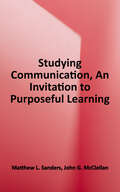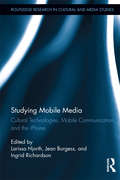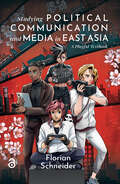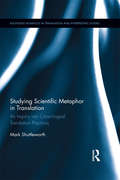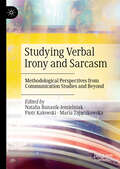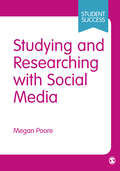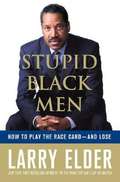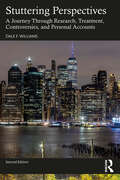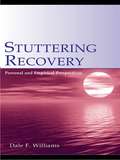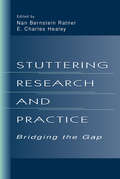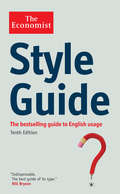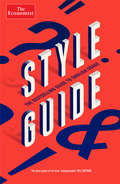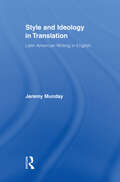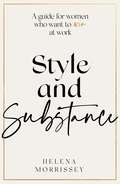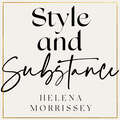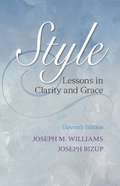- Table View
- List View
Studies in English Language: English Compounds and Their Spelling (Studies in English Language)
by Christina Sanchez-StockhammerAnyone writing texts in English is constantly faced with the unavoidable question whether to use open spelling (drinking fountain), hyphenation (far-off) or solid spelling (airport) for individual compounds. While some compounds commonly occur with alternative spellings, others show a very clear bias for one form. This book tests more than sixty hypotheses and explores the patterns underlying the spelling of English compounds from a variety of perspectives. Based on a sample of 600 biconstituent compounds with identical spelling in all reference works in which they occur (200 each with open, hyphenated and solid spelling), this empirical study analyses large amounts of data from corpora and dictionaries and concludes that the spelling of English compounds is not chaotic but actually correlates with a large number of statistically significant variables. An easily applicable decision tree is derived from the data and an innovative multidimensional prototype model is suggested to account for the results.
Studies in English Language: Listening to the Past
by Raymond HickeyAudio recordings of English are available from the first half of the twentieth century and thus complement the written data sources for the recent history of the language. This book is the first to bring together a team of globally recognised scholars to document and analyse these early recordings in a single volume. Looking at examples of regional varieties of English from England, Scotland, Ireland, the USA, Canada and other anglophone countries, the volume explores both standard and vernacular varieties, and demonstrates how accents of English have changed between the late nineteenth century and the present day. The socio-phonetic examinations of the recordings will be of interest to scholars of historical linguistics, the history of the English language, language variation and change, phonetics, and phonology.
Studies in Ethnopragmatics, Cultural Semantics, and Intercultural Communication: Ethnopragmatics and Semantic Analysis
by Bert Peeters Kerry Mullan Lauren SadowThis book is the first in a three-volume set that celebrates the career and achievements of Cliff Goddard, a pioneer of the Natural Semantic Metalanguage approach in linguistics. In addition, it explores ethnopragmatics and conversational humour, with a further focus on semantic analysis more broadly.Often considered the most fully developed, comprehensive and practical approach to cross-linguistic and cross-cultural semantics, Natural Semantic Metalanguage is based on evidence that there is a small core of basic, universal meanings (semantic primes) that can be expressed in all languages. It has been used for linguistic and cultural analysis in such diverse fields as semantics, cross-cultural communication, language teaching, humour studies and applied linguistics, and has reached far beyond the boundaries of linguistics into ethnopsychology, anthropology, history, political science, the medical humanities and ethics.
Studies in Language and Social Interaction: In Honor of Robert Hopper (Routledge Communication Series)
by Jennifer MandelbaumThis collection offers empirical studies and theoretical essays about human communication in everyday life. The writings come from many of the world's leading researchers and cut across academic boundaries, engaging scholars and teachers from such disciplines as communication, sociology, anthropology, linguistics, and education. Chapters emphasize empirical, qualitative studies of people's everyday uses of talk-in-interaction, and they feature work in such areas as sociolinguistics, conversation analysis, discourse analysis, and ethnography. The volume is dedicated to and highlights themes in the work of the late Robert Hopper, an outstanding scholar in communication who pioneered research in Language and Social Interaction (LSI). The contributors examine various features of human interaction (such as laughter, vocal repetition, and hand gestures) occurring naturally within a variety of settings (at a dinner table, a doctor's office, an automotive repair shop, and so forth), whereby interlocutors accomplish aspects of their interpersonal or institutional lives (resolve a disagreement, report bad medical news, negotiate a raise, and more), all of which may relate to larger social issues (including police brutality, human spirituality, death, and optimism). The chapters in this anthology show that social life is largely a communicative accomplishment and that people constitute the social realities experienced every day through small and subtle ways of communicating, carefully orchestrated but commonly taken for granted. In showcasing the diversity of contemporary LSI research, this volume is appropriate for scholars and graduate students in language and social interaction, communication, sociology, research methods, qualitative research methods, discourse analysis, conversation analysis, linguistics, and related areas.
Studies on Learning and Teaching Chinese as a Second Language
by Xin Jiang Xiaohong Sharon WenStudies on Learning and Teaching Chinese as a Second Language represents the current advances in the field. It showcases theoretically motivated empirical studies and diverse methods used for a better understanding of how Chinese language is acquired as a second or foreign language. This contributes to L2 acquisition research in general and L2 Chinese specifically. Furthermore, this research is useful for teachers seeking to understand their students’ learning processes and adjust their pedagogical approach for more effective instruction. The book bridges the gap between research and instruction by providing pedagogical implications rooted in empirical findings.
Studies on Urban Vehicular Ad-hoc Networks
by Minglu Li Hongzi ZhuWith the advancement of wireless technology, vehicular ad hoc networks (VANETs) are emerging as a promising approach to realizing "smart cities" and addressing many important transportation problems such as road safety, efficiency, and convenience. This brief provides an introduction to the large trace data set collected from thousands of taxis and buses in Shanghai, the largest metropolis in China. It also presents the challenges, design issues, performance modeling and evaluation of a wide spectrum of VANET research topics, ranging from realistic vehicular mobility models and opportunistic routing, to real-time vehicle tracking and urban sensing applications. In addition to the latest research and techniques, the reader will also learn the trace-driven methodologies and tools of performance modeling and analysis, network protocol design and optimization, and network simulation, thus keeping pace with the fast moving VANET research and development.
Studies on the History and Culture Along the Continental Silk Road (Silk Road Research Series)
by Xiao LiThis book presents outstanding articles addressing various aspects related to the ancient Silk Road, in particular the cultural, political, and economic interactions that took place among the civilizations and cultures on the Eurasian continent. In addition, the articles help to reveal the hallmark features of cultural communication in Inner Asia in different historical periods. The book develops a new approach to studying the civilizations of the Silk Road, promotes interdisciplinary and multi-dimensional research, sets a new direction for Chinese ancient classics and western sinology, and presents the latest discoveries, including both archaeological finds and historical documents.
Studying Communication: An Invitation to Purposeful Learning
by Matthew L. Sanders John G. McClellan"Throughout this book we encourage students to have conversations about what they are learning and why it matters and they need to have many of these conversations with you! It is only when thoughtful instructors engage students in meaningful discussions about the field of communication and how it connects to their individual goals that the full potential of studying communication can be realized. What we are asking students to do is hard, and they need your help to guide them through the important discussions that will shape their understanding and their ability to articulate the value of studying communication and its connection to their personal potential and success. We hope you can use this book to spark conversations in the classroom and in your offices about being an intentional learner, complementing the ideas here with your own perspectives, to make it meaningful for your individual students and specific academic program." - authors
Studying Mobile Media: Cultural Technologies, Mobile Communication, and the iPhone (Routledge Research in Cultural and Media Studies)
by Jean Burgess Larissa Hjorth Ingrid RichardsonThe iPhone represents an important moment in both the short history of mobile media and the long history of cultural technologies. Like the Walkman of the 1980s, it marks a juncture in which notions about identity, individualism, lifestyle and sociality require rearticulation. this book explores not only the iPhone’s particular characteristics, uses and "affects," but also how the "iPhone moment" functions as a barometer for broader patterns of change. In the iPhone moment, this study considers the convergent trajectories in the evolution of digital and mobile culture, and their implications for future scholarship. Through the lens of the iPhone—as a symbol, culture and a set of material practices around contemporary convergent mobile media—the essays collected here explore the most productive theoretical and methodological approaches for grasping media practice, consumer culture and networked communication in the twenty-first century.
Studying Political Communication and Media in East Asia: A Playful Textbook
by Florian SchneiderCommunication is at the heart of politics, and certainly in East Asia, where vibrant media systems and cultural industries connect with political processes that range from the democratic to autocratic. If we are to understand East Asian societies, and 21st-century politics more broadly, we need to take media and communication seriously. This textbook provides a flexible toolbox of methods and theories for studying political communication. Taking its examples and exercises from Japan, Korea, and the Chinese-speaking world, it walks readers through core issues, media contents, and communicative modes. Readers will learn how to systematically analyse the politics of media environments, written and spoken words, images and visual designs, moving image, space and spatial interactions, (video)games, and more. The chapters can be used individually or, optionally, as a playful ‘gamified’ course that offers learners a first-hand experience of how complex ‘information societies’ incentivise behaviour.
Studying Scientific Metaphor in Translation (Routledge Advances in Translation and Interpreting Studies)
by Mark ShuttleworthStudying Scientific Metaphor in Translation presents a multilingual examination of the translation of metaphors. Mark Shuttleworth explores this facet of translation and develops a theoretically nuanced description of the procedures that translators have recourse to when translating metaphorical language. Drawing on a core corpus consisting of six Scientific American articles in the fields of neurobiology and biotechnology dating from 2004, along with their translations into Chinese, French, German, Italian, Polish and Russian, Shuttleworth provides a data-driven and theoretically informed picture of the processes that underpin metaphor translation. The book builds interdisciplinary bridges between translation scholars and metaphor researchers, proposes a new set of procedures for metaphor translation conceived within the context of descriptive translation studies, and puts forward a possible resolution to the debate on metaphor translatability.
Studying Verbal Irony and Sarcasm: Methodological Perspectives from Communication Studies and Beyond
by Natalia Banasik-Jemielniak Piotr Kałowski Maria ZajączkowskaThis volume provides a comprehensive yet accessible introduction to the phenomenon of verbal irony and sarcasm and the methodological aspects of its study. The chapters employ quantitative and qualitative measures of the use of verbal irony and sarcasm in both adults and children, with methods ranging from questionnaires and comment elicitation through experimental studies to a qualitative analysis of naturalistic data. By examining the phenomena in a range of contexts, the volume also show that cultural norms of communication may affect both the use and understanding of irony in specific ways and should therefore be taken into account in research.
Studying and Researching with Social Media (Student Success)
by Megan PooreWondering what your lecturers are looking for in a blog post? Asking yourself how that’s different from writing an essay (or a wiki page)? Unsure if Twitter really can be used to build your online profile as a researcher? If you want – or need – to integrate social media tools into your studies and research, this practical book is your one-stop shop. Megan Poore shares the secrets of how to harness the power of social media tools to improve your academic productivity. Inside, you’ll find out how to: ... write a good blog post ... contribute to a wiki ... maximise your grades when creating an audio-visual presentation ... find and share the latest research via Twitter ... keep safe online. Featuring handy illustrations and exercises, as well as guidance on broader issues such as copyright, avoiding plagiarism, and cyberbullying, you’ll find out all you need to successfully use social media to support your study and research. Visit the Studying and Researching with Social Media blog which accompanies the book, sharing tips and guidance on using social media to improve your study and research skills. The Student Success series are essential guides for students of all levels. From how to think critically and write great essays to planning your dream career, the Student Success series helps you study smarter and get the best from your time at university. Visit the SAGE Study Skills hub for tips and resources for study success!
Stupid Black Men: How to Play the Race Card - and Lose
by Larry ElderIS LIFE UNFAIR FOR BLACK AMERICANS? IS RACIAL EQUALITY THE ANSWER TO EVERY QUESTION OF PUBLIC POLICY? IS A HUGE GROUP OF CITIZENS BEING KEPT DOWN BY "THE MAN"? RADIO HOST AND BESTSELLING AUTHOR Larry Elder has made a career out of being a thorn in the side of the conventional-wisdom crowd. He deflates the pompous and points out the completely logical truths hidden behind the nutty rhetoric and out-of-control pandering of politicians and the so-called leaders of a variety of special-interest groups. In Stupid Black Men, he takes on the mind-set of those people who always capture the most media attention-as well as masses of public money-people who say that racism is the root of all problems and who end up hurting precisely those they claim to be helping. Whether they are demagogues like Al Sharpton, established politicians like Hillary Clinton, or entertainers like Danny Glover, no one escapes Elder's cogent arguments and rapier wit. His sometimes hilarious and always infuriating examples of wrong-headedness skewer not just politicians for their smugness and hypocrisy but also actors, educators, religious leaders, and the "mainscream media" for keeping the story in the headlines. But Elder has a positive message, too: though they are fewer-and generally not as loudmouthed-there are leaders and role models today who want to sweep away race-based whining and urge everyone in America to share in the hard work, smart thinking, and optimism that make this country great.
Stuttering Perspectives: A Journey Through Research, Treatment, Controversies, and Personal Accounts
by Dale F. WilliamsStuttering Perspectives is a highly engaging book that interweaves discussion and research about stuttering with personal accounts. Written in a reader-friendly and informal style, the book considers stuttering from a variety of angles, providing the reader with a nuanced and holistic view. In this way, topics such as therapy, support groups, listener reactions, and many others are not only explained within the context of current research, but also illustrated with lively examples demonstrating the stuttering experience. Fully updated in its second edition, the book includes new stories, additional discussion questions, and inclusion of contemporary stuttering issues not contained in the original version. This book is highly relevant reading for speech and language professionals, as well as students of communication sciences and disorders. It will also be of great interest to people who stutter and anyone with an interest in fluency disorders.
Stuttering Recovery: Personal and Empirical Perspectives
by Dale F. WilliamsStuttering Recovery: Personal and Empirical Perspectives is a highly original and engaging book serving to not only educate readers on topics related to stuttering, but also to stimulate discussion. The author interweaves personal accounts of people who stutter with informational chapters highlighting up-to-date research on recovery-related issues such as therapy, support groups, listener reactions, risk-taking, and dealing with family members and significant others.Reader-friendly and understandable, this book incorporates various perspectives to teach and illustrate the different aspects of recovery. Chapters are paired with stories presenting all sides of the recovery process -- the humorous and serious, the uplifting and frustrating, the thoughtful and emotional, and everything in-between. The result is a text that is entertaining and instructive.Stuttering Recovery: Personal and Empirical Perspectives is intended for undergraduate and graduate students, clinicians, speech-language professionals, people who stutter, significant others, and anyone else who has an interest in fluency disorders.
Stuttering Research and Practice: Bridging the Gap
by Nan Bernstein Ratner and E. Charles HealeyCurrent approaches to treating stuttering do not reflect the new understanding of its nature which has emerged from recent studies. This book brings together speech scientists and clinicians to discuss the best ways to close the perceived gap and maximize the effectiveness of treatment. Together, the chapters offer a comprehensive state-of-the-art overview of the complexities of stuttering and its remediation. Genetic, neuropsychological, behavioral, and often-neglected affective and cognitive factors are all considered. Preferred methodologies for empirical investigation are described, and specific examples of applied clinical research designs are provided. The book will be crucial reading for all those professionally concerned with fluency disorders and their students.
Style Guide
by Bill BrysonThis expanded tenth edition of the bestselling guide to style is based on the Economist's own updated house style manual, and is an invaluable companion for everyone who wants to communicate with the clarity, style and precision for which the Economist is renowned. As the introduction says, 'clarity of writing usually follows clarity of thought. ' The Economist Style Guide gives general advice on writing, points out common errors and clichés, offers guidance on consistent use of punctuation, abbreviations and capital letters, and contains an exhaustive range of reference material - covering everything from accountancy ratios and stock market indices to laws of nature and science. Some of the numerous useful rules and common mistakes pointed out in the guide include: *Which informs, that defines. This is the house that Jack built. But: This house, which Jack built, is now falling down. *Discreet means circumspect or prudent; discrete means separate or distinct. Remember that "Questions are never indiscreet. Answers sometimes are" (Oscar Wilde). *Flaunt means display, flout means disdain. If you flout this distinction you will flaunt your ignorance *Forgo means do without; forego means go before. *Fortuitous means accidental, not fortunate or well-timed. *Times: Take care. Three times more than X is four times as much as X. *Full stops: Use plenty. They keep sentences short. This helps the reader.
Style Guide (Economist Books)
by The EconomistThis expanded twelfth edition of the bestselling guide to style is based on The Economist's own updated house style manual, and is an invaluable companion for everyone who wants to communicate with the clarity, style and precision for which The Economist is renowned.As the introduction says, 'clarity of writing usually follows clarity of thought.'The Economist Style Guide gives general advice on writing, points out common errors and clichés, offers guidance on consistent use of punctuation, abbreviations and capital letters and contains an exhaustive range of reference material--covering everything from accountancy ratios and stock market indices to laws of nature and science.Some of the numerous useful rules and common mistakes pointed out in the guide include:Which informs, that defines. This is the house that Jack built. But: This house, which Jack built, is now falling down.Discreet means circumspect or prudent; discrete means separate or distinct. Remember that "Questions are never indiscreet. Answers sometimes are" (Oscar Wilde).Flaunt means display, flout means disdain. If you flout this distinction you will flaunt your ignorance.Forgo means do without; forego means go before.Fortuitous means accidental, not fortunate or well-timed.Times: Take care. Three times more than X is four times as much as X.Full stops: Use plenty. They keep sentences short. This helps the reader.
Style and Ideology in Translation: Latin American Writing in English (Routledge Studies in Linguistics #Vol. 8)
by Jeremy MundayAdopting an interdisciplinary approach, this book investigates the style, or ‘voice,’ of English language translations of twentieth-century Latin American writing, including fiction, political speeches, and film. Existing models of stylistic analysis, supported at times by computer-assisted analysis, are developed to examine a range of works and writers, selected for their literary, cultural, and ideological importance. The style of the different translators is subjected to a close linguistic investigation within their cultural and ideological framework.
Style and Substance: A guide for women who want to win at work
by Helena Morrissey'An inspiring guide to developing your personal brand, achieving your career goals and shaping the future of work' Red'Everything every career woman needs to know and yet is rarely shared so honestly' Anya Hindmarch'Refreshingly relevant and practical' Roksanda IlincicWomen have made great advances in the workplace, but despite that - and the overwhelming amount of career advice out there - the same questions continue to arise: how to succeed in a man's world, how to combine a career with a family, how to be authentic and fit in, and whether it is even possible to achieve a work-life balance while chasing career goals.Unfortunately, much of the advice women are offered is badly out of date and lacking in 'cut-to-the-chase' strategies that really tally with their experience of the workplace now. What's more, the advice often tends to be defensive, focused on overcoming obstacles rather than drawing upon strengths.Style and Substance starts from a very different perspective. Written by Helena Morrissey, who has learned through her own experiences as a woman in the workplace and as a business leader,it will help you understand what really matters when it comes to career progression today, whatever your age, situation and aspirations.Style and Substance will show you how to build your own style - your personal brand - and how to have confidence in it, and in yourself. Once you realise how much agency you have and the steps that you can take to look the part, sound the part, feel the part and therefore be the part, you'll be empowered to achieve your goals in your own way, secure in who you are and what you have to offer.
Style and Substance: A guide for women who want to win at work
by Helena Morrissey'This is a kind book. Everything every career woman needs to know and yet is rarely shared so honestly' Anya HindmarchWomen have made great advances in the workplace, but despite that - and the overwhelming amount of career advice out there - the same questions continue to arise: how to succeed in a man's world, how to combine a career with a family, how to be authentic and fit in, and whether it is even possible to achieve a work-life balance while chasing career goals.Unfortunately, much of the advice women are offered is badly out of date and lacking in 'cut-to-the-chase' strategies that really tally with their experience of the workplace now. What's more, the advice often tends to be defensive, focused on overcoming obstacles rather than drawing upon strengths.Style and Substance starts from a very different perspective. Written by Helena Morrissey, who has learned through her own experiences as a woman in the workplace and as a business leader,it will help you understand what really matters when it comes to career progression today, whatever your age, situation and aspirations.Style and Substance will show you how to build your own style - your personal brand - and how to have confidence in it, and in yourself. Once you realise how much agency you have and the steps that you can take to look the part, sound the part, feel the part and therefore be the part, you'll be empowered to achieve your goals in your own way, secure in who you are and what you have to offer.
Style and Substance: A guide for women who want to win at work
by Helena Morrissey'An inspiring guide to developing your personal brand, achieving your career goals and shaping the future of work' Red'Everything every career woman needs to know and yet is rarely shared so honestly' Anya Hindmarch'Refreshingly relevant and practical' Roksanda IlincicWomen have made great advances in the workplace, but despite that - and the overwhelming amount of career advice out there - the same questions continue to arise: how to succeed in a man's world, how to combine a career with a family, how to be authentic and fit in, and whether it is even possible to achieve a work-life balance while chasing career goals.Unfortunately, much of the advice women are offered is badly out of date and lacking in 'cut-to-the-chase' strategies that really tally with their experience of the workplace now. What's more, the advice often tends to be defensive, focused on overcoming obstacles rather than drawing upon strengths.Style and Substance starts from a very different perspective. Written by Helena Morrissey, who has learned through her own experiences as a woman in the workplace and as a business leader,it will help you understand what really matters when it comes to career progression today, whatever your age, situation and aspirations.Style and Substance will show you how to build your own style - your personal brand - and how to have confidence in it, and in yourself. Once you realise how much agency you have and the steps that you can take to look the part, sound the part, feel the part and therefore be the part, you'll be empowered to achieve your goals in your own way, secure in who you are and what you have to offer.
Style in Translation: A Corpus-Based Perspective
by Libo HuangThis book attempts to explore style--a traditional topic--in literary translation with a corpus-based approach. A parallel corpus consisting of the English translations of modern and contemporary Chinese novels is introduced and used as the major context for the research. The style in translation is approached from perspectives of the author/the source text, the translated texts and the translator. Both the parallel model and the comparable model are employed and a multiple-complex model of comparison is proposed. The research model, both quantitative and qualitative, is duplicable within other language pairs. Apart from the basics of corpus building, readers may notice that literary texts offer an ideal context for stylistic research and a parallel corpus of literary texts may provide various observations to the style in translation. In this book, readers may find a close interaction between translation theory and practice. Tables and figures are used to help the argumentation. The book will be of interest to postgraduate students, teachers and professionals who are interested in corpus-based translation studies and stylistics.
Style: Lessons in Clarity and Grace Eleventh Edition
by Joseph M. Williams Joseph BizupWilliams' own clear, accessible style models the kind of writing that audiences-both in college and after-will admire. The principles offered here help writers understand what readers expect and encourage writers to revise to meet those expectations more effectively. This book is all you need to understand the principles of effective writing.
